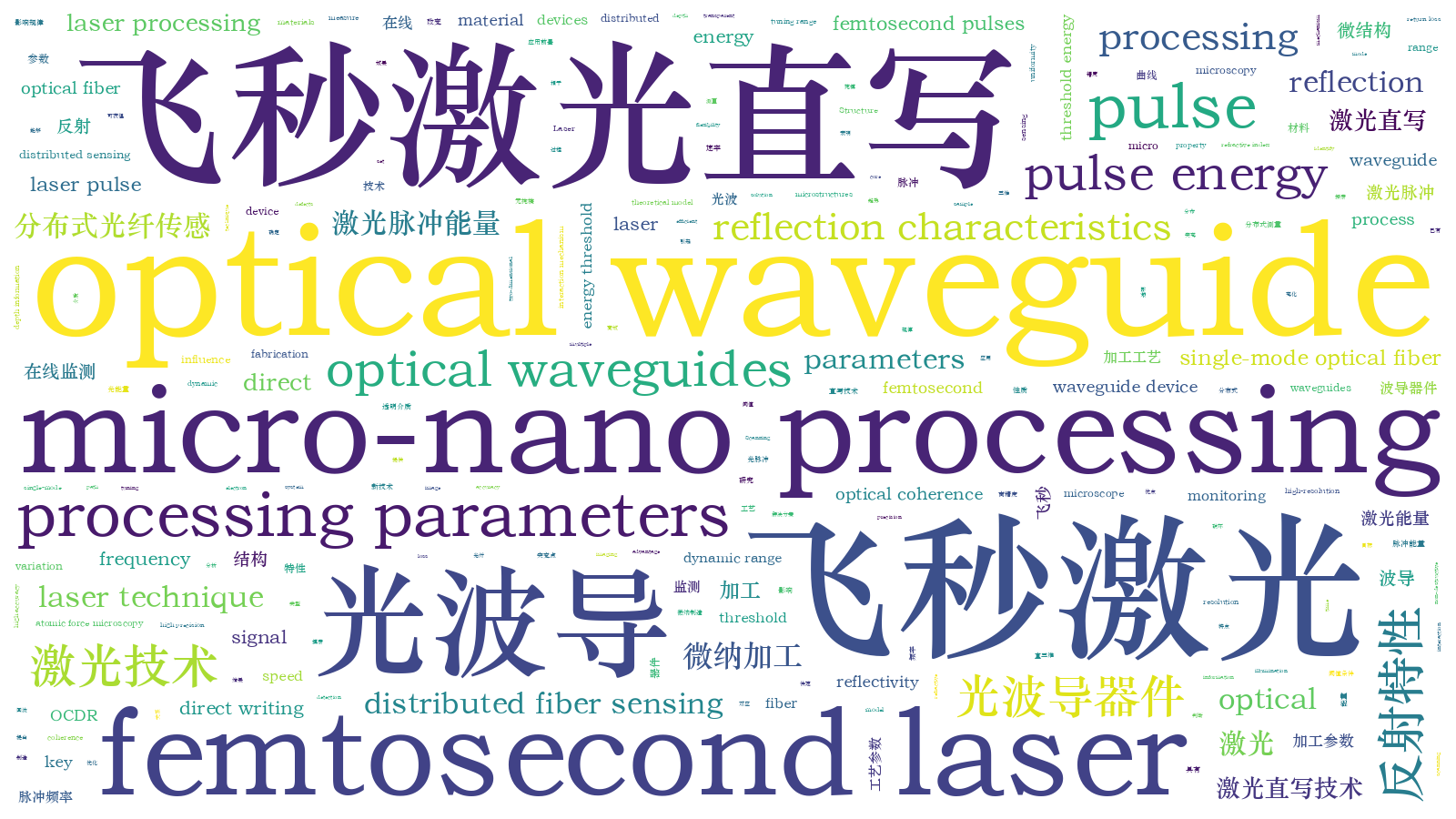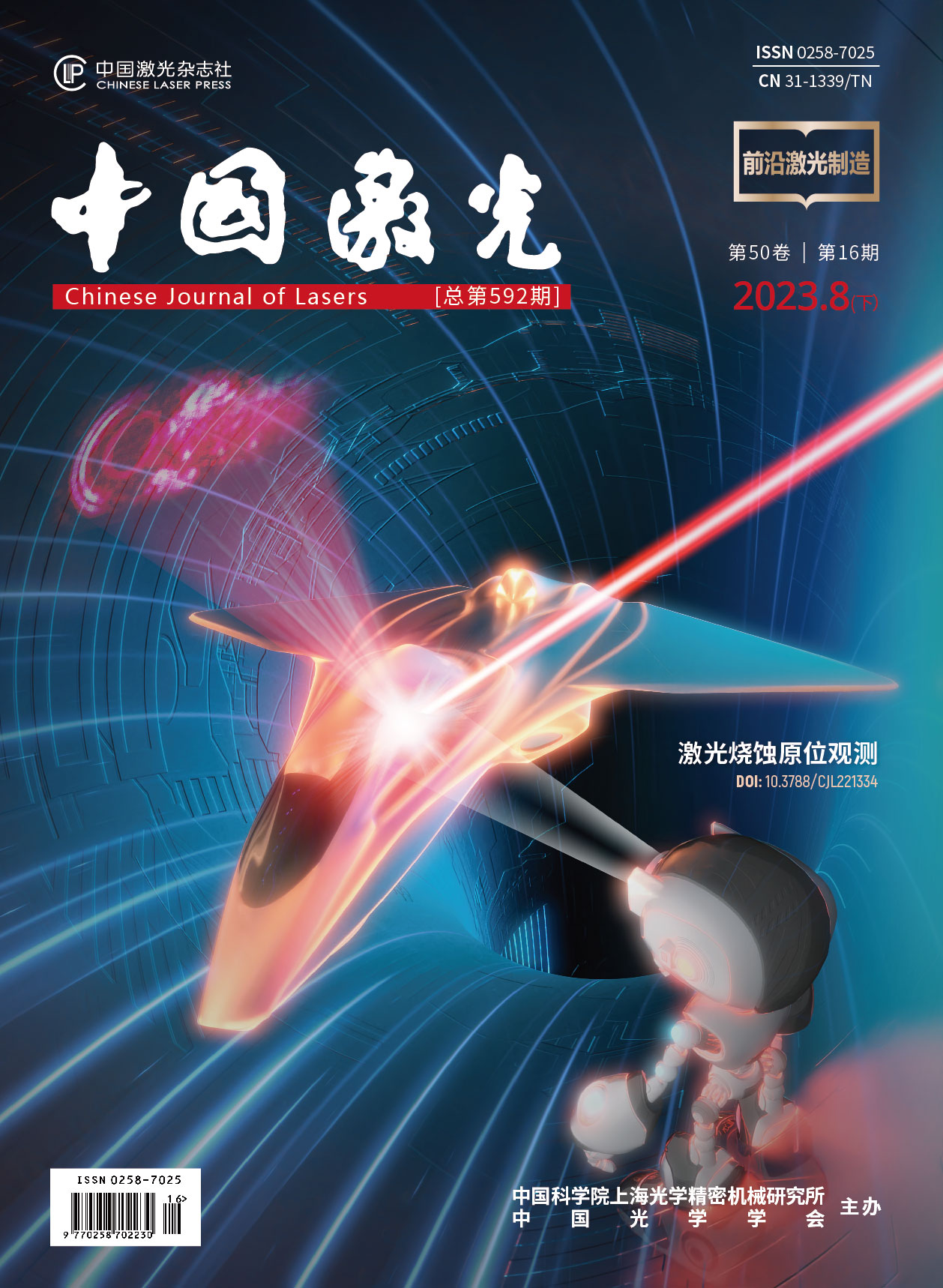基于OCDR的飞秒激光直写光波导微结构在线监测  下载: 599次
下载: 599次
Femtosecond laser direct-writing plays a key role in optical waveguide device fabrication owing to its advantages of being maskless, true three-dimension, high precision, and flexibility. However, due to the lack of a mature theoretical model that can completely describe the interaction mechanism of the laser pulse with different materials, numerous experiments are required to determine the set of optimal processing parameters. Scanning electron microscopy or atomic force microscopy can provide high-resolution images of fabricated samples, but they generally need the sample to be destroyed, which is a time-consuming process. An optical microscope combined with a laser processing system can be used for in-process monitoring. However, the material to be processed needs to be transparent to illumination, and the resolution of the optical microscope is generally limited. Recently, methods based on optical coherence imaging have been proposed to obtain depth information in addition to a two-dimensional image. However, owing to the limited dynamic range detection, these methods cannot be used to measure the weak scattered signal induced by the small refractive index of the material in optical waveguide device processing. Therefore, in-process techniques for efficiently determining the processing parameters of femtosecond laser direct-writing optical waveguide devices are useful and significant.
The backward reflection signal induced by femtosecond laser direct-writing optical waveguide devices was used for the in-process monitoring of the key processing parameters. We developed coherence domain reflectometry (OCDR) (Fig. 1) with a large reflection dynamic range (-10 dB to -95 dB) and high accuracy (±1.0 dB) to measure the reflection signal. By directly writing micro-nano defects in the core of a single-mode optical fiber with different processing parameters, backward reflection signals were generated and subsequently detected by the OCDR connected to one port of the fiber (Fig. 2). The variation tendency of the measured reflection curve was used to determine the optimal processing parameters, and the reflection for a specific case was used to identify the type of change in the material (Fig. 5).
The influence of three key parameters, that is, the pulse energy, pulse frequency, and direct writing speed of the femtosecond laser, on the backward reflection signal in fiber micro-nano processing is studied using OCDR. By increasing the pulse energy (fixed pulse frequency of 1 kHz), the variation tendency of the measured reflectivity can be divided into four different regions A, B, C, and D (Fig. 4), where the abrupt change point (0.355 μJ) between A and B is identified as the pulse energy threshold, and B is the optimal region for optical waveguide device writing owing to its relatively low return loss and large reflectivity tuning range. A similar behavior is also observed when the pulse frequency is changed (fixed pulse energy 0.415 μJ) (Fig. 6). By scanning the pulse frequency at different pulse energies, the threshold points for different setups of the two key parameters are obtained (Fig. 7). The results show that the threshold energy gradually decreases with an increase in the pulse frequency. By the distributed monitoring of the reflection signal along the direct writing path, we find that the reflectivity decreases with an increase in the writing speed (Fig. 8), and the uniformity of the reflectivity curve can be improved by multiple writing (Fig. 9).
A distributed sensing technique based on OCDR for the in-process monitoring of direct-writing microstructures in optical waveguides with femtosecond pulses is proposed. The measured backward reflection signal is used to determine the optimal fabrication parameters. The influence of three key parameters, that is, pulse energy, pulse frequency, and direct writing speed, on the backward reflection signal in fiber micro-nano processing is studied by OCDR. The measured results show that the threshold conditions of the pulse energy and pulse frequency that cause material property changes can be determined quickly and accurately via abrupt changes in the reflection curve, and the type of material property change can also be identified according to the curve variation and reflectivity. In addition, the influence of the direct writing speed on the fabrication uniformity is determined by taking advantage of the distributed sensing ability of the OCDR. This work provides a non-destructive, efficient, and in-process solution for exploring the processing parameters of femtosecond laser direct-writing optical waveguide devices.
1 引言
自1996年第一次被证实能够在透明介质内部诱导折射率改变[1]以来,飞秒激光直写技术以其真三维、无掩模、加工灵活等独特的优势,被广泛应用于光纤光栅[2-7]、光纤微结构[8-13]、光子芯片[14-19]等透明介质波导器件的加工中。尽管目前已有大量关于飞秒激光对透明介质材料折射率修饰的研究报道[20-24],但仍没有成熟理论模型能够完全描述其对介质材料折射率的作用机理。在实际加工中,为了获得较好的加工效果,往往需要根据目标材料的特性进行大量实验研究,反复探索和优化激光加工参数,过程繁琐且复杂。
目前,飞秒激光直写工艺参数的研究通常采用电子扫描显微镜和原子力显微镜进行后处理验证[25-30],尽管这种方法可提供大量基于处理结构的高分辨率图像优化参数集的信息,但无法呈现加工的动态过程及瞬态,这意味着每一个流程都需要稳定且可重复,因此需要大量的时间和生产成本。此外,将飞秒激光加工系统与高分辨光学显微镜相结合以获取激光加工微结构图像的方法也已被广泛应用到波导器件加工中[17,31-34],此方法可对加工参数进行适当的实时反馈控制,在没有最佳加工参数的情况下,可对未知材料进行加工,且能直接观察加工后的结构。然而,使用光学显微镜进行过程监测时,目标样品仅限于对照明光透明的材料,且仅限于在样品表面附近加工,以防止样品受衍射影响。最近,一些基于相干成像的在线的监测手段被用于飞秒激光加工效果的测量表征[35-39],这些技术不仅可获得加工结构的二维平面形貌,还能获得加工深度信息。然而这些手段对背向散射信号的测量动态范围有限,尽管可用于表征破坏性的微纳加工,但对飞秒激光波导器件加工中材料改性产生的折射率改变引起的微弱散射信号的测量能力不足。
为快速获得飞秒激光直写光波导器件的工艺参数及加工效果,本文提出了一种基于光相干域反射仪(OCDR)在已有波导中确定飞秒激光直写加工微结构的分布式、在线监测技术。不同于已有的飞秒激光加工工艺监测手段,本文利用OCDR系统的高回波损耗测量精度和大动态范围,通过加工波导器件过程中的背向反射信号变化实现工艺参数的监测。以飞秒激光直写光纤微结构为实验对象,研究了激光脉冲能量、脉冲频率及直写速率三个关键工艺参数对光纤反射特性的影响,建立了OCDR测量的反射特征曲线与加工工艺参数的对应关系模型。通过该模型能够快速准确地确定引起材料性质改变的激光能量和脉冲频率的阈值条件,且根据曲线变化趋势和反射曲线特点可判断材料性质改变的类型。此外,利用OCDR的分布式、在线监测能力,还获得了直写速率对加工效果的影响规律。
2 实验装置及原理
2.1 OCDR系统原理
光相干域反射仪系统原理图如
分别使用
式中:
发生干涉的两列光波必须满足光程差在光源的相干长度内,假设SLD光源输出的是理想的高斯光谱,且不考虑系统色散的影响,系统理论分辨率(
式中:

图 2. OCDR性能验证。(a)SLD光源光谱;(b)OCDR测量的光纤中两个缺陷点反射曲线
Fig. 2. OCDR performance verification. (a) Spectrum of SLD source; (b) reflection curves of two defect points in optical fiber measured by OCDR
2.2 实验装置
OCDR在线监测飞秒激光直写加工实验装置如

图 3. OCDR系统在线监测的飞秒激光光纤微加工实验装置图
Fig. 3. Femtosecond laser fiber micromachining experimental device monitored online by OCDR system
3 结果与讨论
飞秒激光加工参数众多,本实验系统中激光波长、脉冲宽度、聚焦物镜倍率和数值孔径为固定参数,利用聚焦透镜参数计算得到的激光焦斑[43]直径为496.75 nm,焦深为376.33 nm,实际加工过程中仅通过改变激光脉冲能量、激光脉冲频率及直写速率来调控加工效果,下文将分别对其进行分析研究。
3.1 飞秒激光脉冲能量对加工光纤的影响
飞秒激光脉冲能量是引起材料性质改变的决定性参数,本实验采用的单模光纤对飞秒激光通常是透明的,但经过物镜聚焦后激光峰值功率密度很容易达到石英材料的非线性效应阈值,引起强非线性吸收,从而诱导焦点处高度局域化的折射率改变[20]。光纤中局部折射率改变则会引起光信号的反射现象,根据菲涅耳定律可知折射率改变量的大小与反射率正相关,这为OCDR在线监测提供了理论依据。
将待加工的光纤样品夹持在精心设计的V形槽光纤夹具上,利用三维超精密移动平台实现其精确的定位和移动,将光纤一端与OCDR系统连接,基于飞秒激光在光纤纤芯中心位置写入点结构。为避免后加工的反射信号对先加工的反射信号测量的影响,采用从远端逐渐靠近OCDR测试端口的加工方式。
为验证上述结论,本实验进一步分析了每个区域选取特征点的反射信号,并采用高倍显微镜对该位置形貌变化进行了表征。

图 5. 不同脉冲能量区域特征点的OCDR测量反射曲线及显微图像
Fig. 5. Reflection curves and microscopic images of feature points in different pulse energy regions measured by OCDR
3.2 飞秒激光脉冲频率对加工光纤的影响
脉冲频率是影响飞秒激光直写微结构尺寸和形貌的关键参数之一。研究表明:随着飞秒激光频率的增加,脉冲产生的热量将发生累积,而折射率的改变涉及热效应的形成,因而加工尺寸增大[45]。同样,光纤中折射率改变区域的面积增大也会引起反射率的增大,从而使得OCDR监测的反射曲线发生变化。
3.3 飞秒激光直写速率以及扫描方式对加工光纤的影响
在飞秒激光工艺中,除了加工点外,还有线、面等多种结构,直写速率则是重要的影响因素。直写速率影响着相邻两光斑之间的能量累积效应,直接决定了一定尺度内的脉冲累积的数量,从而影响加工质量。速率越慢,脉冲数越多,能量累积越明显;而速率越快,脉冲数越少,能量积累越弱。
针对脉冲能量高于损伤阈值但当直写速率为300 μm/s时移动过程中未产生明显反射现象的情况,设计了重复扫描方案以确定该能量能够引起光纤折射率改性,扫描方向沿光纤纤芯传输方向,速度为300 μm/s,扫描长度为220 μm。

图 9. 脉冲频率为1 kHz、脉冲能量为0.44 μJ、直写速率为300 μm/s、扫描次数为7时的OCDR反射率变化
Fig. 9. OCDR reflectivity changes when pulse frequency is 1 kHz, pulse energy is 0.44 μJ, direct writing speed is 300 μm/s, and number of scans is 7
4 结论
高效的加工工艺参数监测手段可极大提升飞秒激光直写加工效率,降低工艺摸索成本。提出了一种基于高分辨率、高动态范围OCDR在线监测波导中飞秒激光直写微结构或器件的新技术。以飞秒激光直写光纤微结构为实验对象,研究了激光脉冲能量、脉冲频率及直写速率三个关键工艺参数对光纤反射特性的影响规律,建立了OCDR测量反射特征曲线与加工参数的对应关系。通过该模型能够快速准确地确定引起材料性质改变的激光能量和脉冲频率的阈值条件,且根据曲线变化趋势和反射峰特点可判断材料性质改变类型,为实际加工中快速选择最佳脉冲能量和脉冲频率提供了参考。此外,利用OCDR的分布式、在线监测能力,还获得了直写速率对加工效果的影响规律。该技术为飞秒激光直写加工光波导微结构或器件工艺参数的快速确定及加工过程的实时监测提供了一种新的思路。
[1] Momma C, Chichkov B N, Nolte S, et al. Short-pulse laser ablation of solid targets[J]. Optics Communications, 1996, 129(1/2): 134-142.
[2] Antipov S, Ams M, Williams R J, et al. Direct infrared femtosecond laser inscription of chirped fiber Bragg gratings[J]. Optics Express, 2016, 24(1): 30-40.
[3] Ioannou A, Theodosiou A, Caucheteur C, et al. Direct writing of plane-by-plane tilted fiber Bragg gratings using a femtosecond laser[J]. Optics Letters, 2017, 42(24): 5198-5201.
[4] Kondo Y, Nouchi K, Mitsuyu T, et al. Fabrication of long-period fiber gratings by focused irradiation of infrared femtosecond laser pulses[J]. Optics Letters, 1999, 24(10): 646-648.
[5] Li B Y, Jiang L, Wang S M, et al. Femtosecond laser fabrication of long period fiber gratings and applications in refractive index sensing[J]. Optics & Laser Technology, 2011, 43(8): 1420-1423.
[6] Theodosiou A, Lacraz A, Polis M, et al. Modified fs-laser inscribed FBG array for rapid mode shape capture of free-free vibrating beams[J]. IEEE Photonics Technology Letters, 2016, 28(14): 1509-1512.
[7] Yang K M, Liao C R, Liu S, et al. Optical fiber tag based on an encoded fiber Bragg grating fabricated by femtosecond laser[J]. Journal of Lightwave Technology, 2020, 38(6): 1474-1479.
[8] Wei T, Han Y K, Tsai H L, et al. Miniaturized fiber inline Fabry-Perot interferometer fabricated with a femtosecond laser[J]. Optics Letters, 2008, 33(6): 536-538.
[9] Ran Z L, Liu S, Liu Q, et al. Novel high-temperature fiber-optic pressure sensor based on etched PCF F-P interferometer micromachined by a 157-nm laser[J]. IEEE Sensors Journal, 2015, 15(7): 3955-3958.
[10] Liu Y, Li M, Zhao P J, et al. High sensitive temperature sensor based on a polymer waveguide integrated in an optical fibre micro-cavity[J]. Journal of Optics, 2018, 20(1): 015801.
[11] Deng J, Wang D N. Construction of cascaded Fabry-Perot interferometers by four in-fiber mirrors for high-temperature sensing[J]. Optics Letters, 2019, 44(5): 1289-1292.
[12] Wang Q H, Zhang H, Wang D N. Cascaded multiple Fabry-Perot interferometers fabricated in no-core fiber with a waveguide for high-temperature sensing[J]. Optics Letters, 2019, 44(21): 5145-5148.
[14] Chen Q Q, Song H, Zhang F T, et al. A strategy for fabrication of controllable 3D pattern containing clusters and nanoparticles inside a solid material[J]. Nanoscale, 2017, 9(26): 9083-9088.
[15] Grenier J R, Fernandes L A, Herman P R. Femtosecond laser writing of optical edge filters in fused silica optical waveguides[J]. Optics Express, 2013, 21(4): 4493-4502.
[16] He Y, Zhu L, Liu Y, et al. Femtosecond laser direct writing of flexible all-reduced graphene oxide FET[J]. IEEE Photonics Technology Letters, 2016, 28(18): 1996-1999.
[17] Wong S, Deubel M, Pérez-Willard F, et al. Direct laser writing of three- dimensional photonic crystals with a complete photonic bandgap in chalcogenide glasses[J]. Advanced Materials, 2006, 18(3): 265-269.
[18] Yu F, Tian Z N, Piacentini S, et al. Resetting directional couplers for high-fidelity quantum photonic integrated chips[J]. Optics Letters, 2021, 46(20): 5181-5184.
[20] Taylor R, Hnatovsky C, Simova E. Applications of femtosecond laser induced self-organized planar nanocracks inside fused silica glass[J]. Laser & Photonics Review, 2008, 2(1/2): 26-46.
[21] Tu C H, Huang Z C, Zhang S G, et al. Second harmonic generation by femtosecond Yb-doped fiber laser source based on PPKTP waveguide fabricated by femtosecond laser direct writing[J]. Optics Communications, 2011, 284(1): 455-459.
[22] Hirao K, Miura K. Writing waveguides and gratings in silica and related materials by a femtosecond laser[J]. Journal of Non-Crystalline Solids, 1998, 239(1/2/3): 91-95.
[23] Ponader C W, Schroeder J F, Streltsov A M. Origin of the refractive-index increase in laser-written waveguides in glasses[J]. Journal of Applied Physics, 2008, 103(6): 063516.
[24] Bricchi E, Klappauf B G, Kazansky P G. Form birefringence and negative index change created by femtosecond direct writing in transparent materials[J]. Optics Letters, 2004, 29(1): 119-121.
[25] Liu X Q, Chen Q D, Guan K M, et al. Dry-etching-assisted femtosecond laser machining[J]. Laser & Photonics Reviews, 2017, 11(3): 1600115.
[26] Li Z Z, Wang L, Fan H, et al. O-FIB: far-field-induced near-field breakdown for direct nanowriting in an atmospheric environment[J]. Light: Science & Applications, 2020, 9: 41.
[27] Qian M D, Sun Y L, Hu Z Y, et al. Fluorescent chemo-sensors based on “dually smart” optical micro/nano-waveguides lithographically fabricated with AIE composite resins[J]. Materials Horizons, 2020, 7(7): 1782-1789.
[28] Bruneau S, Hermann J, Dumitru G, et al. Ultra-fast laser ablation applied to deep-drilling of metals[J]. Applied Surface Science, 2005, 248(1/2/3/4): 299-303.
[29] Coyne E, Magee J, Mannion P, et al. Study of femtosecond laser interaction with wafer-grade silicon[J]. Proceedings of SPIE, 2003, 4876: 487-499.
[30] 赵强, 万辉, 于圣韬, 等. 飞秒激光制备柔性纳米多孔Ag材料的研究[J]. 中国激光, 2021, 48(8): 0802009.
[31] Marshall G D, Dekker P, Ams M, et al. Directly written monolithic waveguide laser incorporating a distributed feedback waveguide-Bragg grating[J]. Optics Letters, 2008, 33(9): 956-958.
[32] Döring S, Richter S, Nolte S, et al. In situ imaging of hole shape evolution in ultrashort pulse laser drilling[J]. Optics Express, 2010, 18(19): 20395-20400.
[35] Webster P J L, Muller M S, Fraser J M. High speed in situ depth profiling of ultrafast micromachining[J]. Optics Express, 2007, 15(23): 14967-14972.
[36] Tomlins P H, Smith G N, Woolliams P D, et al. Femtosecond laser micro-inscription of optical coherence tomography resolution test artifacts[J]. Biomedical Optics Express, 2011, 2(5): 1319-1327.
[37] Webster P J L, Wright L G, Mortimer K D, et al. Automatic real-time guidance of laser machining with inline coherent imaging[J]. Journal of Laser Applications, 2011, 23(2): 022001.
[38] Hayashi N, Hoshikawa M, Ishii K, et al. In-process measurement of a keyhole using a low-coherence interferometer with a high repetition rate[J]. Optics Express, 2021, 29(20): 32169-32178.
[39] Hasegawa S, Fujimoto M, Atsumi T, et al. In-process monitoring in laser grooving with line-shaped femtosecond pulses using optical coherence tomography[J]. Light: Advanced Manufacturing, 2022, 3(3): 33.
[40] Takada K, Yokohama I, Chida K, et al. New measurement system for fault location in optical waveguide devices based on an interferometric technique[J]. Applied Optics, 1987, 26(9): 1603-1606.
[41] WuS B, HaoJ X, ChenX J, et al. Location resolved internal structure identification and defect detection in PIC chips with optical coherence domain reflectometer[C]∥Conference on Lasers and Electro-Optics: Applications and Technology, May 15-20, 2022, San Jose, California, USA. Washington, D.C.: Optica Publishing Group, 2022: JW3B.180.
[42] 孟卓. 全光纤口腔OCT方法研究与系统研制[D]. 天津: 天津大学, 2008: 16-20.
MengZ. Research on method and system development of all fiber oral OCT[D]. Tianjin: Tianjin University, 2008: 16-20.
[43] 国旗. 面向苛刻环境耐高温光纤光栅的制备及传感特性研究[D]. 长春: 吉林大学, 2022: 35-40.
GuoQ. Research on fabrication and sensing characteristics of high temperature resistant fiber gratings for harsh environments[D]. Changchun: Jilin University, 2022: 35-40.
[44] Glezer E N, Mazur E. Ultrafast-laser driven micro-explosions in transparent materials[J]. Applied Physics Letters, 1997, 71(7): 882-884.
[45] Eaton S M, Zhang H B, Herman P R, et al. Heat accumulation effects in femtosecond laser-written waveguides with variable repetition rate[J]. Optics Express, 2005, 13(12): 4708-4716.
Article Outline
夏龙, 王新悦, 吴胜保, 崔省伟, 冯亭, 姚晓天. 基于OCDR的飞秒激光直写光波导微结构在线监测[J]. 中国激光, 2023, 50(16): 1602402. Long Xia, Xinyue Wang, Shengbao Wu, Shengwei Cui, Ting Feng, X. Steve Yao.











